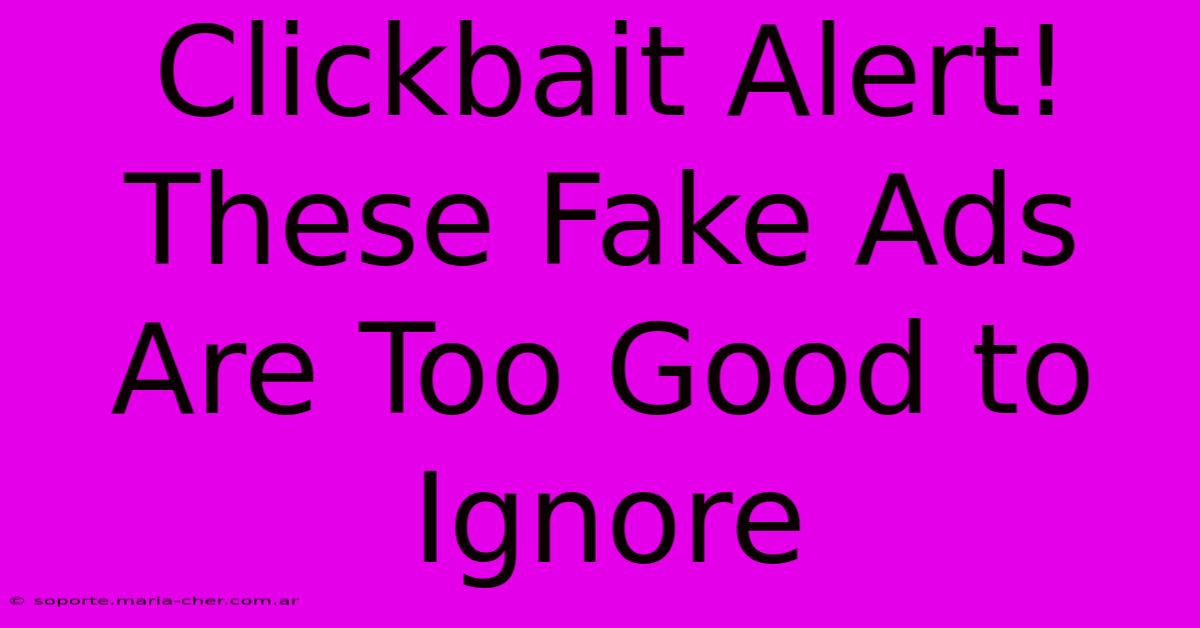Clickbait Alert! These Fake Ads Are Too Good To Ignore

Table of Contents
Clickbait Alert! These Fake Ads Are Too Good to Ignore
Are you tired of seeing those ridiculously tempting ads promising unbelievable deals or miraculous results? We are too! The internet is overflowing with cleverly disguised fake ads, designed to lure you in with promises that are simply too good to be true. This article will equip you with the knowledge to spot these clickbait traps and protect yourself from scams.
The Allure of the Fake Ad
Fake ads prey on our desires. They tap into our longing for:
- Financial freedom: Ads promising quick riches, get-rich-quick schemes, or effortless money-making opportunities are classic examples.
- Improved health and beauty: Products claiming miraculous weight loss, wrinkle removal, or overnight beauty transformations are often fraudulent.
- Technological advancements: Ads featuring revolutionary gadgets or software with unbelievable capabilities are frequently misleading.
These ads are expertly crafted, using high-quality images, compelling testimonials (often fake), and urgent calls to action. They often exploit a sense of urgency ("Limited time offer!", "Only a few left!") to pressure you into clicking.
How to Spot a Fake Ad
While some fake ads are blatant, others are surprisingly subtle. Here's how to identify them:
1. Unrealistic Promises:
This is the biggest red flag. If an ad promises something too good to be true, it probably is. Be wary of claims that sound too amazing to be real. Think critically: Does the offer seem legitimate? Is it consistent with reality?
2. Poor Grammar and Spelling:
Legitimate businesses usually invest in professional marketing materials. If an ad is riddled with grammatical errors or spelling mistakes, it's a strong indicator of a scam.
3. Generic Stock Photos and Videos:
Fake ads often rely on generic stock photos and videos, easily identifiable through reverse image searches. Legitimate companies tend to use original, high-quality imagery.
4. Lack of Contact Information:
Legitimate businesses are transparent and provide clear contact information. If an ad lacks a physical address, phone number, or email address, be cautious.
5. Suspicious Website:
Clicking on the ad might lead to a poorly designed website with unprofessional formatting, broken links, or suspicious domain names.
6. Pressuring Language:
Fake ads often use urgent and high-pressure language, creating a sense of urgency and fear of missing out (FOMO). Don't fall for this tactic.
7. Request for Personal Information:
Be extremely cautious about ads that request personal information such as your bank details, social security number, or credit card information before you've verified the legitimacy of the company.
Protecting Yourself From Fake Ads
- Do your research: Before clicking on an ad or making a purchase, research the company online. Check reviews and look for evidence of scams.
- Use ad blockers: Ad blockers can help reduce the number of fake ads you encounter.
- Report suspicious ads: Report suspicious ads to the platform where you saw them (e.g., Facebook, Google, etc.).
- Be skeptical: Don't be swayed by emotionally charged language or promises that sound too good to be true.
Conclusion: Think Before You Click!
The internet is a vast and wonderful place, but it's also filled with deceptive practices. By learning to identify fake ads and exercising caution, you can protect yourself from scams and avoid falling victim to clickbait. Remember, if something seems too good to be true, it probably is. Always think before you click!

Thank you for visiting our website wich cover about Clickbait Alert! These Fake Ads Are Too Good To Ignore. We hope the information provided has been useful to you. Feel free to contact us if you have any questions or need further assistance. See you next time and dont miss to bookmark.
Featured Posts
-
Step Into The Monochrome Uncover The Magic Of Black And White At These Hidden Gems
Feb 07, 2025
-
The Ultimate Guide To Empty Effective Flyer Marketing Dominate Google Discovery And Drive Traffic
Feb 07, 2025
-
Youthful Brilliance How Millennial Ph Ds Are Revolutionizing Academia
Feb 07, 2025
-
Discover The Future Of Font Technology Futura Now Trial The Ultimate Upgrade
Feb 07, 2025
-
Raise A Glass To Grace Exquisite Invitations For A Sophisticated Milestone
Feb 07, 2025
